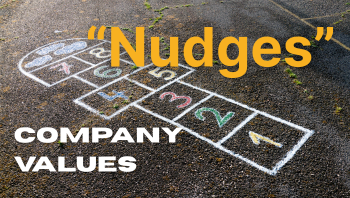Values Factory: Actively shaping culture through "NUDGES"
Values are not monuments, but construction sites. They must be nurtured, questioned, and developed further.
This is especially true now, when social debate is intensifying.
Concrete value development beyond declarations of intent: How can it be achieved?
If companies continue to consciously commit to a value orientation, the question arises: How can this further development be achieved in concrete terms, beyond well-sounding declarations of intent? And how can the current upheavals be dealt with in practice, especially in the areas of sustainability, diversity, equity, and inclusion (DEI)?
Energy and direction through participation
The development of values itself is becoming more participatory. Instead of top-down decrees, modern approaches rely on broader participation. In-depth discussions are not something to be “put up with” here, but rather the actual purpose of the exercise.
This primarily happens at the beginning in face-to-face events, where values are created and can be experienced directly and simultaneously: “What values have made our company successful in the past?” and “What values do we need in light of current and future challenges in order to be successful, both externally and internally?”
But online tools – from digital surveys and virtual whiteboards to (AI-supported) text analysis of employee feedback – can also help here. They enable even large organizations to continuously gauge moods, initiate discussions, and develop a common understanding. But be careful: tools are just tools, not solutions. They are no substitute for dialogue and the often difficult process of negotiation.
“Nudges” – gentle prompts for value-compliant behavior in everyday life
The key to putting values into practice is translating them into nudges (gentle prompts): small, often unconscious nudges can help promote value-compliant behavior in everyday life. The most important lever here is that so-called default settings can be used to steer behavior toward corporate values.
Example: sustainability – less waste and more exercise in the office
One company removed all decentralized trash cans and printers so that employees have to go to a central trash point or printer.
The result: less paper consumption (people think twice before printing) and more exercise in the office – a nudge in favor of environmental awareness and health.
Example: Healthy eating made easy: nudges in the canteen
Canteens can work in a similar way with default settings: offer healthy or vegetarian options first, display fruit at eye level – freedom of choice remains, but the desired option is promoted.
Examples of “the power of the environment”: anchoring values through workplace design
The physical work environment can be designed to remind people of values.
Example: integrity
Studies show that simply hanging pictures of ethical role models (respected personalities who stand for integrity) influences behavior. Employees act measurably more ethically when such stimuli are present in the office.
Example: cooperation
Office concepts that encourage chance encounters also nudge toward an open culture. Internal nudges have the same effect: mixing departments and creating open meeting places playfully promotes teamwork and encourages employees to leave their silos more often.
Social and temporal nudges: implicit control of values through norms and timing
Social norms and timing can also be used to implicitly control values.
Promoting a culture of health: “walking meetings” as a default option
In meeting tools, the “walking meeting” option could be preset and marked as the recommended choice. Studies show that when employees are presented with the choice between “classic sitting” and “walking” with a small note (“chosen by most: walking”), moving meetings take place significantly more often – a nudge toward health and innovation (fresh air promotes creative thinking).
Embed appreciation: “Kudo cards” and “praise tools” for positive reinforcement
To embed the value of appreciation or recognition, you can use kudo cards or digital “praise tools” for “random acts of kindness,” which encourage regular feedback. When colleagues see that behavior that reflects values (e.g., helpfulness, customer focus) is publicly praised, they are more likely to follow suit. These social nudges work because they offer positive reinforcement rather than coercion – and increase intrinsic motivation.
After the nudges, in the next focus article we will look at how culture can be actively shaped through structures.
LINKS to VALUE TOOLS
Cultureamp Link to a very clear website and well-visualized DEI product
Nudging in the company A good explanation of the topic “nudging in the workplace” with examples.


About me

All Rights Reserved
Get in touch
-
+49-(0)941 600 93 003
-
This email address is being protected from spambots. You need JavaScript enabled to view it. -
Thomas_Huber
ToChange Gmbh
-
Thomas Huber
-
Traubengasse 6
-
D-93059 Regensburg

